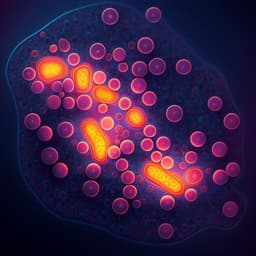
Medicine and Health
Full spectrum fluorescence lifetime imaging with 0.5 nm spectral and 50 ps temporal resolution
G. O. S. Williams, E. Williams, et al.
This paper introduces a groundbreaking high-speed optical scanning microscope that captures time-resolved images across 512 spectral and 32 time channels within a single acquisition, providing insights into complex organic structures. The research by Gareth O. S. Williams and colleagues demonstrates its potential through imaging various samples, including human lung tissue, revealing intricate spectral changes.
~3 min • Beginner • English
Introduction
The study addresses the need for simultaneous, high-resolution measurement of fluorescence emission spectra and lifetimes to unmix complex fluorescent signals in heterogeneous environments (e.g., biological tissues). Emission properties of fluorophores are influenced by factors such as energy transfer, pH, viscosity, temperature, and quenching pathways, often causing subtle spectral shifts of only a few nanometers and changes in lifetime. Prior full-spectral FLIM systems were constrained by data volume and speed, limiting them to a small number of spectral channels and often requiring multiple sequential acquisitions that introduce photobleaching and motion artefacts. The research question is whether a single-pass, full-spectral, time-resolved imaging system with high spectral (∼0.5 nm) and temporal (∼50 ps) resolution can be realized to capture a complete wavelength–lifetime data cube per pixel at practical imaging speeds. The authors present a confocal scanning FS-FLIM microscope built around a 512-channel TCSPC SPAD line sensor with on-chip histogramming, aiming to deliver unprecedented spectral/temporal resolution and speed, reduce data bottlenecks, and provide robust optical fingerprints in complex samples including human tissue.
Literature Review
- Time-resolved emission spectroscopy (TRES) enables enhanced signal unmixing by capturing both emission spectra and lifetimes, but practical systems have been limited by data throughput and acquisition speed.
- Commercial lifetime imaging (e.g., Leica Stellaris) can improve spectral resolution by rapid sequential acquisitions with incremental detection wavelength shifts; however, multiple passes slow acquisition and exacerbate photobleaching and motion artefacts.
- Prior systems using SPAD line arrays, including time-gating, have demonstrated feasibility but often with limited spectral channels and reliance on off-chip timing electronics and significant PCB complexity.
- The state of the art lacked a system capable of single-pass capture of a full spectral–lifetime data cube per pixel at fine spectral resolution, with on-chip histogramming to manage data volume and increase dynamic range.
- The manuscript situates itself relative to prior hyperspectral FLIM and phasor-based approaches, and to applications in spectral histopathology and autofluorescence-based tissue diagnostics, where subtle spectral shifts and lifetime changes are diagnostically relevant.
Methodology
Instrument design and optics:
- Core detector: custom 512-channel TCSPC SPAD line sensor with per-pixel on-chip histogramming (photon timing electronics fully on-chip). Each spectral channel comprises 16 SPADs in two columns; time-bins can be paired ("chained") to increase dynamic range (from 10-bit to 20-bit; max counts >2×10^6 per pixel). Temporal resolution: ~50 ps. Photon detection efficiency up to 17%.
- Spectral coverage: 500–760 nm mapped to 512 detector pixels, yielding ~0.5 nm spectral resolution (configurable via grating and focusing optics). System transmission >65%.
- Optical path: predominantly reflective to minimize chromatic aberration; scanning via two galvanometer mirrors re-imaged by spherical mirrors to the back aperture of the objective; diffraction-limited performance from 400–900 nm. Minor modeled astigmatism (peak-to-valley ~0.139 waves) did not degrade the PSF significantly.
- Excitation source: supercontinuum laser (NKT Evo HP), <100 ps pulses at 20 MHz; tunable acousto-optic filter (NKT SuperK Select) provides up to 8 spectral lines (400–700 nm), ~2 nm bandwidth, ~2 mW average power per line.
- Detection: de-scanned confocal path; dichroic (e.g., 488 nm long-pass) blocks excitation; secondary 10×/0.25 NA objective focuses onto a 100 µm pinhole; emission dispersed by a 600 l/mm VPH grating (blazed ~600 nm) onto the SPAD line.
- Objectives: primary Olympus 20×/0.5 NA air (most samples); Olympus 60×/1.25 NA oil (honeybee wing).
- Control and data path: sensor PCB hosts an FPGA for sensor control, on-chip histogram management, USB 3 data transfer, and dual DACs for galvo drive; custom MATLAB 2019b control and post-processing software.
Imaging parameters and processing:
- Typical image: 256×256 pixels; whole spectral cube per pixel (512 spectral channels × time bins). Full-resolution acquisitions achievable in ~6 s depending on photon budget and exposure.
- Pixel dwell/exposure times: 85 µs to 1 ms per pixel depending on sample brightness; example exposures include 500 µs/pixel (Convallaria, honeybee) and 1 ms/pixel (lung tissue tiles).
- Lifetime analysis: least-squares fitting (single-exponential model) using GPUfit; dark counts subtracted; thresholds applied to ensure SNR~10:1 (e.g., 10× background or ≥200 counts). Channels below threshold set to zero/ignored for lifetime fitting.
- To enhance dynamic range, time bins used in chained mode (16 bins total) for many datasets.
- At spectrum edges with low counts, a moving spectral mean of 8 channels (~4 nm) was applied prior to fitting to maintain SNR>10, noting the slight spectral resolution trade-off in those regions.
- Visualization: spectral RGB color mapping by assigning RGB values to each 0.5 nm channel and summing per pixel; transparency modulation weighted by intensity to enhance structural detail in lifetime maps; inverted transparency used to emphasize low-intensity regions when needed.
Samples:
- Convallaria majalis: commercial slice labeled with Safranin and Fast Green; excitation 485 nm; 20×/0.5 NA; 500 µs/pixel.
- Honeybee wing: fixed specimen; 60×/1.25 NA oil; 500 µs/pixel; similar acquisition settings to Convallaria.
- Human lung tissue (non-small cell lung cancer): fresh ex vivo specimen (~6×12 mm) imaged directly (tiles: 256×256 pixels, ~600×600 µm FOV, 1 ms/pixel; translational stage with ~50 µm overlap for stitching). Sequential 4 µm histology slices from the same region prepared: one H&E stained, one unstained; imaged under same FS-FLIM conditions. Ethical approvals obtained (REC ref: 13/ES/0126 and 15/ES/0094) with informed consent.
Data management and performance:
- Theoretical maximum dataset size per 256×256×512×16 (chained) acquisition ~16 Gb; current USB 3 link can introduce up to ~30 s delay for worst-case transfers. FPGA-side color-mapping to 3-channel RGB before transfer is available to reduce data volume; spectral/temporal binning enables higher frame rates (up to ~10 fps at 128×128).
Key Findings
- System capability: Demonstrated full-spectral, time-resolved imaging per pixel with ~0.5 nm spectral and ~50 ps temporal resolution across 512 spectral channels and up to 32 time channels (often used as 16 chained bins for higher dynamic range). Diffraction-limited performance over 400–900 nm; spectrometer configured for 500–760 nm in experiments.
- Data throughput advances: On-chip histogramming and integrated timing electronics reduced data volume and complexity, enabling higher photon throughput, improved SNR, lower excitation intensities, and shorter dwell times.
- Convallaria majalis (Safranin/Fast Green): Clear spectral and lifetime distinctions between dyes; slices at 550 nm (Safranin) and 650 nm (Fast Green) showed markedly different decay characteristics within structurally similar regions; substantial intra-sample heterogeneity in lifetime independent of intensity. 256×256 pixels, 500 µs dwell, full 512-channel lifetime fitting per pixel.
- Honeybee wing (autofluorescence): Subtle pixel-wise spectral shifts of only a few nanometers detected due to high spectral resolution; strong spatial lifetime variation and complex, multi-peaked lifetime histograms across wavelengths, reflecting multiple emitting populations and structural-biochemical variations in the cuticle matrix; lifetime reductions consistent with increased non-radiative pathways from cross-linking/sclerotization.
- Histology slice (H&E stained): Eosin-dominated fluorescence exhibited decreased lifetime in cancerous regions versus transitionary/healthier regions, despite similar intensity spectral shapes with only small peak shifts; lifetime differences likely reflect variations in dye uptake/concentration (self-quenching), local pH/viscosity, and co-staining effects (hematoxylin can increase observed Eosin lifetime). ROIs confirm stronger contrast in lifetime than in intensity spectra.
- Histology slice (unstained): Pronounced lifetime differences between amorphous cancerous regions and healthy alveolar tissue; cancer-associated regions showed red-shifted emission and reduced lifetimes; heterogeneity persists across the sample; inverted transparency views emphasized low-intensity, cancer-like amorphous structure. ROIs showed both spectral and lifetime contrasts, with lifetime reductions correlating with increased cellular density/amorphous tissue typical of cancer.
- Fresh ex vivo lung tissue: FS-FLIM revealed complex multi-population fluorescence with shorter-wavelength components in both cancer and healthier regions; consistent with slices, cancerous regions displayed reduced lifetimes. Mean spectral lifetimes differed between cancerous and transitionary ROIs, supporting the feasibility of FS-FLIM fingerprints to distinguish tissue types in unprocessed samples.
- Imaging performance: Example tiled mosaics covered ~6×2 mm (stained slice) and ~6×1 mm (fresh tissue) using 256×256-pixel tiles at ~600×600 µm FOV each with 1 ms/pixel dwell; repeatability demonstrated (e.g., Convallaria and honeybee imaged three times; fresh tissue limited by availability but consistent across 20 tiles).
Discussion
The presented FS-FLIM system achieves the central objective of capturing a complete wavelength–lifetime data cube per image pixel in a single pass, overcoming previous trade-offs between spectral resolution and acquisition speed. The integration of on-chip histogramming and timing electronics reduces data volume and complexity, enabling higher photon throughput and improved SNR. The high spectral resolution (∼0.5 nm) reveals subtle emission shifts that traditional systems would miss, while the temporal resolution (~50 ps) and confocal architecture provide robust lifetime contrast.
Biological relevance is demonstrated in multiple contexts: label mixtures in plant tissue, intrinsic autofluorescence in insect cuticle, and both stained and unstained human lung tissue. In stained histology, lifetime provides stronger contrast than intensity spectra, differentiating cancerous from transitionary/healthy regions even when spectral shapes are similar. In unstained and fresh tissues, combined spectral and lifetime signatures (including red-shifts and lifetime reductions in amorphous, cancer-associated areas) suggest a path to label-free optical fingerprinting and potential real-time pathology.
The system’s flexibility allows on-FPGA RGB spectral mapping for rapid visualization while preserving options for full data retrieval when needed. Remaining bottlenecks are primarily in data transfer to the PC; software-selectable spectral/temporal binning offers increased frame rates (up to ~10 fps at 128×128) for dynamic applications. While the single-exponential fitting model simplifies computation and supports high-throughput analysis, it may deviate from true lifetime values in regions with multiple emitters or perturbed decays; future multi-exponential or model-free approaches could further refine accuracy at added computational cost. Overall, the findings confirm that FS-FLIM at high spectral and temporal resolution provides powerful, complementary contrast mechanisms beyond standard intensity imaging, with direct implications for biomedical diagnostics and materials analysis.
Conclusion
This work introduces a highly sensitive, versatile full-spectral FLIM microscope that simultaneously captures the complete emission spectrum and time-resolved decays per pixel with ~0.5 nm spectral and ~50 ps temporal resolution. Key advances include a 512-channel SPAD line sensor with on-chip histogramming, fully integrated timing electronics, and a reflective confocal scanning optical design enabling diffraction-limited performance. The system demonstrates robust performance across diverse samples, revealing subtle spectral shifts and complex, spatially varying lifetime behavior in both labeled and intrinsic fluorescence. In stained and unstained human lung tissue, FS-FLIM provides enhanced contrast for distinguishing cancer-associated regions, underscoring its potential for high-throughput, label-free histopathology and real-time in vivo diagnostics.
Future directions include: optimization of the data link for real-time full-cube imaging; FPGA-side processing and adaptive spectral/temporal binning to increase frame rates; implementation of more sophisticated lifetime models (multi-exponential or model-free) to better resolve heterogeneous decays; and application to advanced modalities such as full-spectral lifetime FRET and combined fluorescence–Raman imaging for multiplexed bioanalytical studies.
Limitations
- Data transfer bottleneck: Full 256×256×512×16 datasets can reach ~16 Gb, causing up to ~30 s transfer delays over USB 3 for worst-case scenarios; currently limits sequential imaging speed for full-cube acquisitions.
- Photon budget constraints: Ultimate frame rate and SNR are limited by sample brightness and photostability; exposure times must balance signal at spectral extremes versus acquisition time.
- Fitting model simplification: Single-exponential lifetime fitting was used for speed; in regions with multiple emitters or perturbed decays, this can deviate from true lifetimes. More complex models would improve accuracy at the cost of computation.
- Spectral smoothing at low counts: A moving 8-channel (~4 nm) spectral average was applied near spectrum edges to maintain SNR, slightly reducing local spectral resolution.
- Depth and heterogeneity: Fresh tissue measurements may include limited depth contributions; while confocal volume is small relative to structures of interest, heterogeneity and mixed cell populations within ROIs (e.g., ~2,500 µm²) can blur specificity.
- Limited replication/scope: Some datasets (e.g., fresh tissue tiles) were acquired once due to sample constraints; the study does not claim cross-sample statistical significance of lifetimes and does not aim to fully interpret underlying biology.
- Hardware-specific range: Demonstrated spectral range (500–760 nm) depends on grating and optics; while configurable, alternate ranges would require reconfiguration.
Related Publications
Explore these studies to deepen your understanding of the subject.







